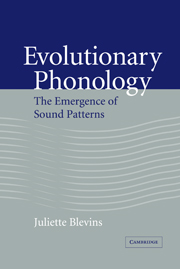10 - Diachronic phonology
Published online by Cambridge University Press: 22 September 2009
Summary
We have a distance to go in restoring the balance between universalist and historical explanation, and in giving full weight to the principle that, to understand a linguistic system, we must know how it came to be.
Labov (1981: 305, citing Jespersen 1924, ch. 2)Historical linguistics includes the study of language change. For many linguists studying language change, it is taken as given that “to understand a linguistic system, we must know how it came to be.” In this chapter I will show that the central findings of Evolutionary Phonology are in concert with this view. The bulk of the arguments presented up to this point demonstrate that there are good historical phonetic explanations for most common sound patterns. As suggested in chapter 9, attributing common sound patterns to common phonetically motivated sound change allows synchronic grammars to be primarily descriptive, liberated from the burden of explanation and naturalness. This is a welcome result, since synchronic markedness accounts seem, at best, to duplicate properties of phonetically motivated sound change or raw frequency effects. At their worst, markedness accounts rule out attested sound patterns, fail to explain why a particular sound pattern is more or less marked than some other, and still make reference to historical explanations when a highly marked pattern arises. Since the bulk of explanation for attested phonological systems is now pushed into the diachronic dimension, one must ask whether the proposed model of sound change is consistent with findings in historical linguistics.
- Type
- Chapter
- Information
- Evolutionary PhonologyThe Emergence of Sound Patterns, pp. 259 - 299Publisher: Cambridge University PressPrint publication year: 2004

